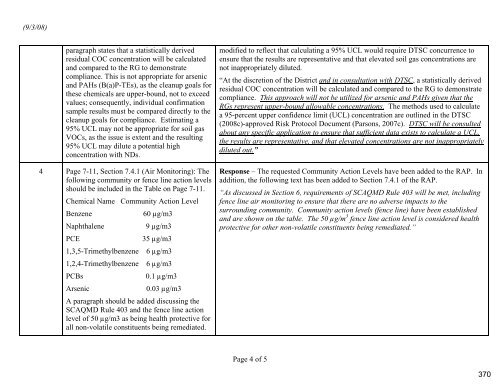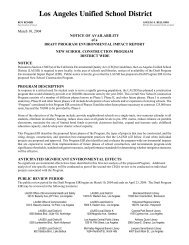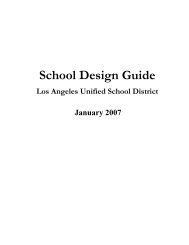Site-Specific Health and Safety Plan (HASP) - Laschools.org
Site-Specific Health and Safety Plan (HASP) - Laschools.org
Site-Specific Health and Safety Plan (HASP) - Laschools.org
You also want an ePaper? Increase the reach of your titles
YUMPU automatically turns print PDFs into web optimized ePapers that Google loves.
(9/3/08)<br />
paragraph states that a statistically derived<br />
residual COC concentration will be calculated<br />
<strong>and</strong> compared to the RG to demonstrate<br />
compliance. This is not appropriate for arsenic<br />
<strong>and</strong> PAHs (B(a)P-TEs), as the cleanup goals for<br />
these chemicals are upper-bound, not to exceed<br />
values; consequently, individual confirmation<br />
sample results must be compared directly to the<br />
cleanup goals for compliance. Estimating a<br />
95% UCL may not be appropriate for soil gas<br />
VOCs, as the issue is extent <strong>and</strong> the resulting<br />
95% UCL may dilute a potential high<br />
concentration with NDs.<br />
4 Page 7-11, Section 7.4.1 (Air Monitoring): The<br />
following community or fence line action levels<br />
should be included in the Table on Page 7-11.<br />
Chemical Name Community Action Level<br />
Benzene 60 µg/m3<br />
Naphthalene 9 µg/m3<br />
PCE 35 µg/m3<br />
1,3,5-Trimethylbenzene 6 µg/m3<br />
1,2,4-Trimethylbenzene 6 µg/m3<br />
PCBs 0.1 µg/m3<br />
Arsenic 0.03 µg/m3<br />
A paragraph should be added discussing the<br />
SCAQMD Rule 403 <strong>and</strong> the fence line action<br />
level of 50 µg/m3 as being health protective for<br />
all non-volatile constituents being remediated.<br />
modified to reflect that calculating a 95% UCL would require DTSC concurrence to<br />
ensure that the results are representative <strong>and</strong> that elevated soil gas concentrations are<br />
not inappropriately diluted.<br />
“At the discretion of the District <strong>and</strong> in consultation with DTSC, a statistically derived<br />
residual COC concentration will be calculated <strong>and</strong> compared to the RG to demonstrate<br />
compliance. This approach will not be utilized for arsenic <strong>and</strong> PAHs given that the<br />
RGs represent upper-bound allowable concentrations. The methods used to calculate<br />
a 95-percent upper confidence limit (UCL) concentration are outlined in the DTSC<br />
(2008c)-approved Risk Protocol Document (Parsons, 2007c). DTSC will be consulted<br />
about any specific application to ensure that sufficient data exists to calculate a UCL,<br />
the results are representative, <strong>and</strong> that elevated concentrations are not inappropriately<br />
diluted out.”<br />
Response – The requested Community Action Levels have been added to the RAP. In<br />
addition, the following text has been added to Section 7.4.1 of the RAP.<br />
“As discussed in Section 6, requirements of SCAQMD Rule 403 will be met, including<br />
fence line air monitoring to ensure that there are no adverse impacts to the<br />
surrounding community. Community action levels (fence line) have been established<br />
<strong>and</strong> are shown on the table. The 50 µg/m 3 fence line action level is considered health<br />
protective for other non-volatile constituents being remediated.”<br />
Page 4 of 5<br />
370







